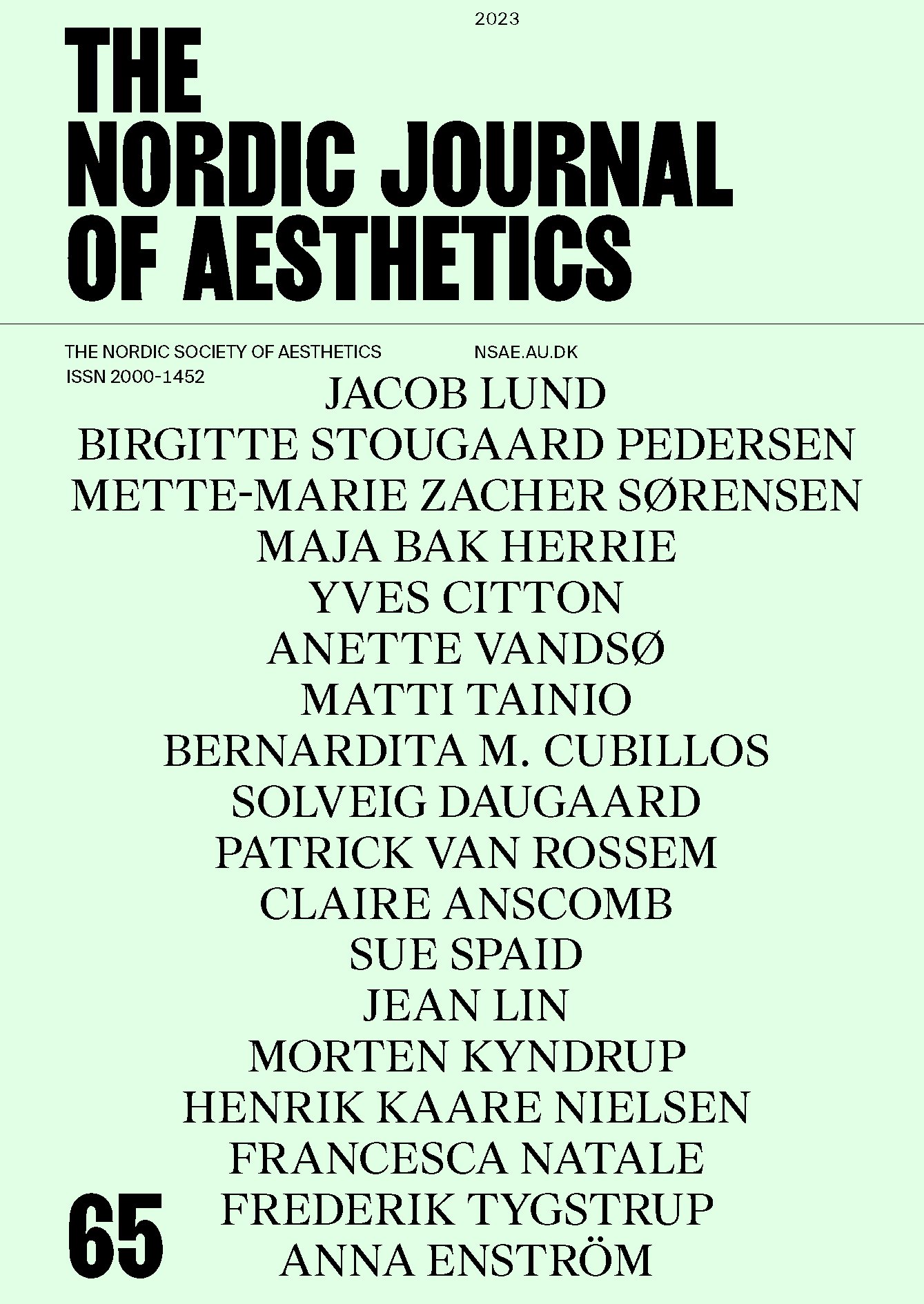Nothing to See? Paying Attention in the Dark Environment
DOI:
https://doi.org/10.7146/nja.v32i65-66.140104Keywords:
Darkness, Visual Perception, Aesthetic Experience, Atmosphere, BurkeAbstract
A cloudy November evening deep in an old forest. It is really dark, and I try to observe my environment. I discern the difference between the treetops and the dark sky and the snow-covered ground. Everything else is formless. My vision is quite useless, and the other senses are weak in these circumstances. Only the background hum is audible and most aromas are erased by the freezing temperature. In a winter outfit, all I can feel is the moving air on my face. Yet, this is not sensory deprivation, there are things to observe. What is it possible to discern when the visual stimulus is minimized? This article focuses on the aesthetic experience of darkness by analyzing a visit to a deep natural darkness and attempts to connect this distinct case to aesthetic theory. The emphasis is on the descriptive analysis of the challenges of seeing in the darkness.
References
Arnold Berleant, The Aesthetics of Environment (Philadelphia: Temple University Press, 1992).
Gernot Böhme, The Aesthetics of Atmospheres, ed. Jean-Paul Thibauld (London: Routledge, 2017).
Emily Brady, The Sublime in Modern Philosophy: Aesthetics, Ethics, and Nature (Cambridge: Cambridge University Press, 2013).
Edmund Burke, A Philosophical Enquiry into the Origin of Our Ideas of the Sublime and Beautiful, 1757, Sect. XIV-XVIII (Cambridge: Cambridge University Press, 2014 [1759]).
Mădălina Diaconu, “Longing for Clouds—Does Beautiful Weather Have to Be Fine?” Contemporary Aesthetics, Vol. 13 (2015).
Tim Edensor, “Reconnecting with Darkness: Gloomy Landscapes, Lightless Places,” Social & Cultural Geography, Vol. 14, No. 4 (2013), https://doi.org/10.1080/14649365.2013.790992.
Daniel Kernell, Colours and Colour Vision. An Introductory Survey (Cambridge: Cambridge University Press, 2016).
Thomas Leddy, “Everyday Surface Aesthetic Qualities: ‘Neat,’ ‘Messy,’ ‘Clean,’ ‘Dirty.’” Journal of Aesthetics and Art Criticism, Vol. 53, No. 3 (1995), https://doi.org/10.2307/431351.
Taylor Stone, “The Value of Darkness: A Moral Framework for Urban Nighttime Lighting,” Science and Engineering Ethics, Vol. 24, No. 2 (2018): https://doi.org/10.1007/s11948-017-9924-0.
Yuriko Saito, “The Aesthetics of Emptiness: Sky Art,” Environment and Planning D: Society and Space, Vol. 29 (2011). https://doi.org/10.1068/d8909.
Downloads
Published
How to Cite
Issue
Section
License
Copyright (c) 2023 Matti Tainio

This work is licensed under a Creative Commons Attribution 4.0 International License.
Authors who publish with this journal agree to the following terms:
- Authors retain copyright and grant the journal right of first publication with the work simultaneously licensed under a Creative Commons Attribution License that allows others to share the work with an acknowledgement of the work's authorship and initial publication in this journal.
- Authors are able to enter into separate, additional contractual arrangements for the non-exclusive distribution of the journal's published version of the work (e.g., post it to an institutional repository or publish it in a book), with an acknowledgement of its initial publication in this journal.
- Authors are permitted and encouraged to post their work online (e.g., in institutional repositories or on their website) prior to and during the submission process, as it can lead to productive exchanges, as well as earlier and greater citation of published work (See The Effect of Open Access).




